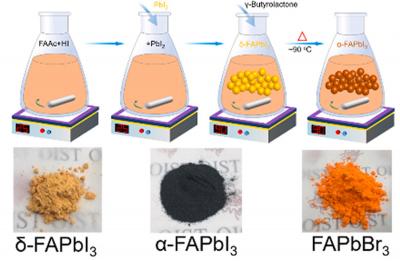researchers at the Okinawa Institute of Science and Technology Graduate University (OIST), led by Professor Yabing Qi, have demonstrated that creating a raw material used for perovskite solar cells in a different way could be key to the success of these cells.

'There's a necessary crystalline powder in perovskites called FAPbI3, which forms the perovskite's absorber layer,' explained one of the lead authors, Dr. Guoqing Tong, Postdoctoral Scholar at OIST. 'Previously, this layer was fabricated by combining two materials ' PbI2 and FAI. The reaction that takes place produces FAPbI3. But this method is far from perfect. There are often leftovers of one or both of the original materials, which can impede the efficiency of the solar cell.'
Another benefit of this method was that the perovskite's stability increased across different temperatures. When the perovskite's absorber layer was formed from the original reaction, it was stable at high temperatures. However, at room temperature, it turned from brown to yellow, which wasn't ideal for absorbing light. The synthesized version was brown even at room temperature.
'Lab-scale solar cells are tiny,' said Prof. Qi. 'The size of each cell is only about 0.1 cm2. Most researchers focus on these because they're easier to create. But, in terms of applications, we need solar modules, which are much larger. The lifespan of the solar cells is also something we need to be mindful of. Although 25% efficiency has previously been achieved, the lifespan was, at most, a few thousand hours. After this, the cell's efficiency started to decline.'
Using the synthesized crystalline perovskite powder, Dr. Tong, alongside Research Unit Technician Dr. Dae-Yong Son and the other scientists in Prof. Qi's Unit, achieved a conversion efficiency of over 23% in their solar cell, but the lifespan was more than 2000 hours. When they scaled up to solar modules of 5x5cm2, they still achieved over 14% efficiency. As a proof-of-concept, they fabricated a device that used a perovskite solar module to charge a lithium ion battery.
These results represent a crucial step towards efficient and stable perovskite-based solar cells and modules that could, one day, be used outside of the lab. 'Our next step is to make a solar module that is 15x15cm2 and has an efficiency of more than 15%,' said Dr. Tong. 'One day I hope we can power a building at OIST with our solar modules.'